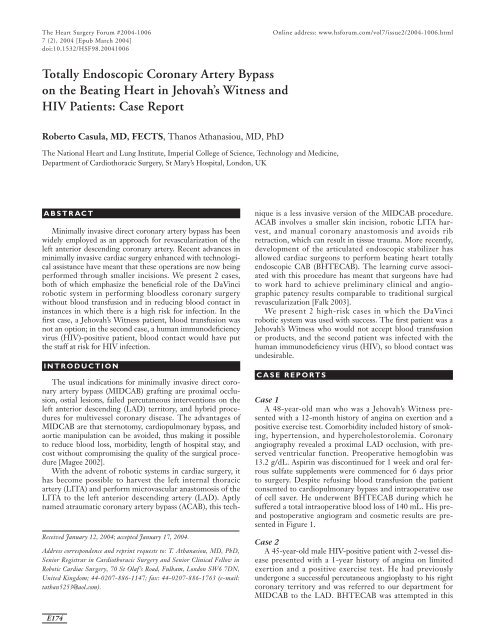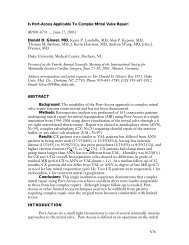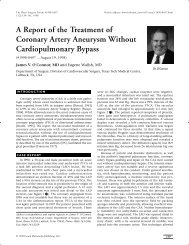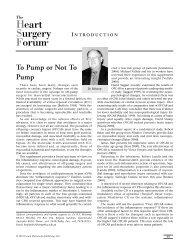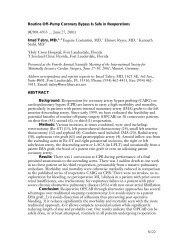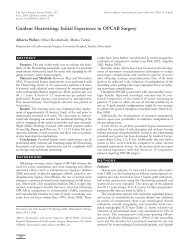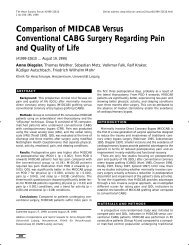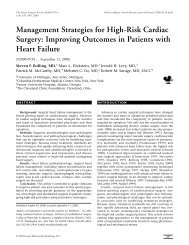Totally Endoscopic Coronary Artery Bypass on the Beating Heart in ...
Totally Endoscopic Coronary Artery Bypass on the Beating Heart in ...
Totally Endoscopic Coronary Artery Bypass on the Beating Heart in ...
Create successful ePaper yourself
Turn your PDF publications into a flip-book with our unique Google optimized e-Paper software.
The <strong>Heart</strong> Surgery Forum #2004-1006<br />
7 (2), 2004 [Epub March 2004]<br />
doi:10.1532/HSF98.20041006<br />
Onl<strong>in</strong>e address: www.hsforum.com/vol7/issue2/2004-1006.html<br />
<str<strong>on</strong>g>Totally</str<strong>on</strong>g> <str<strong>on</strong>g>Endoscopic</str<strong>on</strong>g> <str<strong>on</strong>g>Cor<strong>on</strong>ary</str<strong>on</strong>g> <str<strong>on</strong>g>Artery</str<strong>on</strong>g> <str<strong>on</strong>g>Bypass</str<strong>on</strong>g><br />
<strong>on</strong> <strong>the</strong> <strong>Beat<strong>in</strong>g</strong> <strong>Heart</strong> <strong>in</strong> Jehovah’s Witness and<br />
HIV Patients: Case Report<br />
Roberto Casula, MD, FECTS, Thanos Athanasiou, MD, PhD<br />
The Nati<strong>on</strong>al <strong>Heart</strong> and Lung Institute, Imperial College of Science, Technology and Medic<strong>in</strong>e,<br />
Department of Cardiothoracic Surgery, St Mary’s Hospital, L<strong>on</strong>d<strong>on</strong>, UK<br />
ABSTRACT<br />
M<strong>in</strong>imally <strong>in</strong>vasive direct cor<strong>on</strong>ary artery bypass has been<br />
widely employed as an approach for revascularizati<strong>on</strong> of <strong>the</strong><br />
left anterior descend<strong>in</strong>g cor<strong>on</strong>ary artery. Recent advances <strong>in</strong><br />
m<strong>in</strong>imally <strong>in</strong>vasive cardiac surgery enhanced with technological<br />
assistance have meant that <strong>the</strong>se operati<strong>on</strong>s are now be<strong>in</strong>g<br />
performed through smaller <strong>in</strong>cisi<strong>on</strong>s. We present 2 cases,<br />
both of which emphasize <strong>the</strong> beneficial role of <strong>the</strong> DaV<strong>in</strong>ci<br />
robotic system <strong>in</strong> perform<strong>in</strong>g bloodless cor<strong>on</strong>ary surgery<br />
without blood transfusi<strong>on</strong> and <strong>in</strong> reduc<strong>in</strong>g blood c<strong>on</strong>tact <strong>in</strong><br />
<strong>in</strong>stances <strong>in</strong> which <strong>the</strong>re is a high risk for <strong>in</strong>fecti<strong>on</strong>. In <strong>the</strong><br />
first case, a Jehovah’s Witness patient, blood transfusi<strong>on</strong> was<br />
not an opti<strong>on</strong>; <strong>in</strong> <strong>the</strong> sec<strong>on</strong>d case, a human immunodeficiency<br />
virus (HIV)-positive patient, blood c<strong>on</strong>tact would have put<br />
<strong>the</strong> staff at risk for HIV <strong>in</strong>fecti<strong>on</strong>.<br />
INTRODUCTION<br />
Received January 12, 2004; accepted January 17, 2004.<br />
Address corresp<strong>on</strong>dence and repr<strong>in</strong>t requests to: T. Athanasiou, MD, PhD,<br />
Senior Registrar <strong>in</strong> Cardiothoracic Surgery and Senior Cl<strong>in</strong>ical Fellow <strong>in</strong><br />
Robotic Cardiac Surgery, 70 St Olaf’s Road, Fulham, L<strong>on</strong>d<strong>on</strong> SW6 7DN,<br />
United K<strong>in</strong>gdom; 44-0207-886-1147; fax: 44-0207-886-1763 (e-mail:<br />
tathan5253@aol.com).<br />
The usual <strong>in</strong>dicati<strong>on</strong>s for m<strong>in</strong>imally <strong>in</strong>vasive direct cor<strong>on</strong>ary<br />
artery bypass (MIDCAB) graft<strong>in</strong>g are proximal occlusi<strong>on</strong>,<br />
ostial lesi<strong>on</strong>s, failed percutaneous <strong>in</strong>terventi<strong>on</strong>s <strong>on</strong> <strong>the</strong><br />
left anterior descend<strong>in</strong>g (LAD) territory, and hybrid procedures<br />
for multivessel cor<strong>on</strong>ary disease. The advantages of<br />
MIDCAB are that sternotomy, cardiopulm<strong>on</strong>ary bypass, and<br />
aortic manipulati<strong>on</strong> can be avoided, thus mak<strong>in</strong>g it possible<br />
to reduce blood loss, morbidity, length of hospital stay, and<br />
cost without compromis<strong>in</strong>g <strong>the</strong> quality of <strong>the</strong> surgical procedure<br />
[Magee 2002].<br />
With <strong>the</strong> advent of robotic systems <strong>in</strong> cardiac surgery, it<br />
has become possible to harvest <strong>the</strong> left <strong>in</strong>ternal thoracic<br />
artery (LITA) and perform microvascular anastomosis of <strong>the</strong><br />
LITA to <strong>the</strong> left anterior descend<strong>in</strong>g artery (LAD). Aptly<br />
named atraumatic cor<strong>on</strong>ary artery bypass (ACAB), this technique<br />
is a less <strong>in</strong>vasive versi<strong>on</strong> of <strong>the</strong> MIDCAB procedure.<br />
ACAB <strong>in</strong>volves a smaller sk<strong>in</strong> <strong>in</strong>cisi<strong>on</strong>, robotic LITA harvest,<br />
and manual cor<strong>on</strong>ary anastomosis and avoids rib<br />
retracti<strong>on</strong>, which can result <strong>in</strong> tissue trauma. More recently,<br />
development of <strong>the</strong> articulated endoscopic stabilizer has<br />
allowed cardiac surge<strong>on</strong>s to perform beat<strong>in</strong>g heart totally<br />
endoscopic CAB (BHTECAB). The learn<strong>in</strong>g curve associated<br />
with this procedure has meant that surge<strong>on</strong>s have had<br />
to work hard to achieve prelim<strong>in</strong>ary cl<strong>in</strong>ical and angiographic<br />
patency results comparable to traditi<strong>on</strong>al surgical<br />
revascularizati<strong>on</strong> [Falk 2003].<br />
We present 2 high-risk cases <strong>in</strong> which <strong>the</strong> DaV<strong>in</strong>ci<br />
robotic system was used with success. The first patient was a<br />
Jehovah’s Witness who would not accept blood transfusi<strong>on</strong><br />
or products, and <strong>the</strong> sec<strong>on</strong>d patient was <strong>in</strong>fected with <strong>the</strong><br />
human immunodeficiency virus (HIV), so blood c<strong>on</strong>tact was<br />
undesirable.<br />
CASE REPORTS<br />
Case 1<br />
A 48-year-old man who was a Jehovah’s Witness presented<br />
with a 12-m<strong>on</strong>th history of ang<strong>in</strong>a <strong>on</strong> exerti<strong>on</strong> and a<br />
positive exercise test. Comorbidity <strong>in</strong>cluded history of smok<strong>in</strong>g,<br />
hypertensi<strong>on</strong>, and hypercholestorolemia. <str<strong>on</strong>g>Cor<strong>on</strong>ary</str<strong>on</strong>g><br />
angiography revealed a proximal LAD occlusi<strong>on</strong>, with preserved<br />
ventricular functi<strong>on</strong>. Preoperative hemoglob<strong>in</strong> was<br />
13.2 g/dL. Aspir<strong>in</strong> was disc<strong>on</strong>t<strong>in</strong>ued for 1 week and oral ferrous<br />
sulfate supplements were commenced for 6 days prior<br />
to surgery. Despite refus<strong>in</strong>g blood transfusi<strong>on</strong> <strong>the</strong> patient<br />
c<strong>on</strong>sented to cardiopulm<strong>on</strong>ary bypass and <strong>in</strong>traoperative use<br />
of cell saver. He underwent BHTECAB dur<strong>in</strong>g which he<br />
suffered a total <strong>in</strong>traoperative blood loss of 140 mL. His preand<br />
postoperative angiogram and cosmetic results are presented<br />
<strong>in</strong> Figure 1.<br />
Case 2<br />
A 45-year-old male HIV-positive patient with 2-vessel disease<br />
presented with a 1-year history of ang<strong>in</strong>a <strong>on</strong> limited<br />
exerti<strong>on</strong> and a positive exercise test. He had previously<br />
underg<strong>on</strong>e a successful percutaneous angioplasty to his right<br />
cor<strong>on</strong>ary territory and was referred to our department for<br />
MIDCAB to <strong>the</strong> LAD. BHTECAB was attempted <strong>in</strong> this<br />
E174
The <strong>Heart</strong> Surgery Forum #2004-1006<br />
<str<strong>on</strong>g>Totally</str<strong>on</strong>g> <str<strong>on</strong>g>Endoscopic</str<strong>on</strong>g> <strong>Beat<strong>in</strong>g</strong>-<strong>Heart</strong> CAB <strong>in</strong> Jehovah’s Witness and HIV Patients—<br />
Casula and Athanasiou<br />
Figure 1. Preoperative and postoperative outcome of a Jehovah’s Witness patient undergo<strong>in</strong>g beat<strong>in</strong>g-heart totally endoscopic cor<strong>on</strong>ary artery bypass<br />
surgery. The 4 arrows <strong>in</strong>dicate <strong>the</strong> 4 ports required, with <strong>the</strong> circle represent<strong>in</strong>g <strong>the</strong> <strong>in</strong>serti<strong>on</strong> po<strong>in</strong>t of an endoscopic <strong>in</strong>strument to facilitate <strong>the</strong> cor<strong>on</strong>ary<br />
anastomosis. LITA <strong>in</strong>dicates left <strong>in</strong>ternal thoracic artery.<br />
patient, but because of difficulties encountered dur<strong>in</strong>g <strong>the</strong><br />
LAD preparati<strong>on</strong>, a 4-cm sk<strong>in</strong> <strong>in</strong>cisi<strong>on</strong> had to be performed<br />
(c<strong>on</strong>verted to ACAB) (Figure 2). Total perioperative blood<br />
loss was 200 mL.<br />
SURGICAL AND ANESTHETIC TECHNIQUES<br />
We have previously described <strong>the</strong> details of patient positi<strong>on</strong><strong>in</strong>g,<br />
anes<strong>the</strong>tic methods, and surgical technique used <strong>in</strong><br />
this type of surgery [Casula 2003]. In both cases <strong>the</strong> DaV<strong>in</strong>ci<br />
robotic system was used (Intuitive Surgical, Mounta<strong>in</strong> View,<br />
CA, USA), and <strong>the</strong> LITA was dissected off <strong>the</strong> chest wall<br />
from its bifurcati<strong>on</strong> distally up to <strong>the</strong> level of <strong>the</strong> first rib. A<br />
12-mm port was placed under <strong>the</strong> left costal arch <strong>in</strong> order to<br />
<strong>in</strong>troduce an endoscopic stabilizer (Intuitive Surgical). This<br />
device allowed stabilizati<strong>on</strong> of <strong>the</strong> target vessel by apply<strong>in</strong>g<br />
sucti<strong>on</strong> to <strong>the</strong> epicardium and improved visualizati<strong>on</strong> by<br />
c<strong>on</strong>t<strong>in</strong>uous irrigati<strong>on</strong>. We did not have access to a fourth<br />
robotic arm and thus used endoscopic forceps <strong>in</strong>serted and<br />
manipulated by <strong>the</strong> assistant surge<strong>on</strong> to facilitate <strong>the</strong> c<strong>on</strong>sole<br />
surge<strong>on</strong> dur<strong>in</strong>g <strong>the</strong> <strong>in</strong>itial steps of <strong>the</strong> cor<strong>on</strong>ary anastomosis.<br />
The total surgical time for case 1 was 4 hours and for case 2<br />
was 3.5 hours. LAD occlusi<strong>on</strong> times were 42 and 16 m<strong>in</strong>utes,<br />
respectively.<br />
DISCUSSION<br />
Indicati<strong>on</strong>s for robotic cor<strong>on</strong>ary revascularizati<strong>on</strong> procedures<br />
have not yet been clearly def<strong>in</strong>ed. The technique has<br />
been applied to selected elective patients such as those without<br />
significant left ventricle enlargement, left ventricular dysfuncti<strong>on</strong>,<br />
and <strong>in</strong>tramyocardial cor<strong>on</strong>ary vessels. Relative c<strong>on</strong>tra<strong>in</strong>dicati<strong>on</strong>s<br />
to robotic surgery <strong>in</strong>clude anatomically small<br />
<strong>in</strong>trathoracic space or morbid obesity. Our experience sug-<br />
POSTOPERATIVE COURSE<br />
Both patients were discharged home <strong>on</strong> day 3, and subsequently<br />
underwent postoperative angiography reveal<strong>in</strong>g a<br />
patent LITA. The patients were reviewed <strong>in</strong> <strong>the</strong> outpatient<br />
cl<strong>in</strong>ic 4 weeks postsurgery and had an unremarkable recovery.<br />
Figure 2. Atraumatic cor<strong>on</strong>ary artery bypass <strong>in</strong> a human immunodeficiency<br />
virus–positive patient. Arrow 1 shows <strong>the</strong> endoscopic stabilizer<br />
<strong>in</strong> place and arrow 2 <strong>the</strong> left <strong>in</strong>ternal thoracic artery.<br />
© 2004 Forum Multimedia Publish<strong>in</strong>g, LLC<br />
E175
The <strong>Heart</strong> Surgery Forum #2004-10006<br />
gests that o<strong>the</strong>r high-risk groups may benefit from MIDCAB,<br />
notably Jehovah’s Witnesses and HIV-positive patients, and<br />
highlights <strong>the</strong> l<strong>in</strong>k between robotic techniques and <strong>the</strong> c<strong>on</strong>cept<br />
of bloodless surgery.<br />
Our experience of blood-c<strong>on</strong>serv<strong>in</strong>g surgery <strong>in</strong> <strong>the</strong>se 2<br />
patients supports recent evidence suggest<strong>in</strong>g <strong>the</strong> superiority<br />
of ACAB over direct primary LAD stent<strong>in</strong>g <strong>in</strong> patients suitable<br />
for hybrid myocardial revascularizati<strong>on</strong> (HMR) (multivessel<br />
disease <strong>in</strong>volv<strong>in</strong>g <strong>the</strong> LAD) [Cisowski 2002, Stahl<br />
2002]. In this procedure <strong>the</strong> patient undergoes 2 separate<br />
revascularizati<strong>on</strong> procedures, with <strong>the</strong> surge<strong>on</strong> perform<strong>in</strong>g<br />
ACAB and <strong>the</strong> cardiologist perform<strong>in</strong>g cor<strong>on</strong>ary stent<strong>in</strong>g.<br />
The order of <strong>the</strong>se procedures depends <strong>on</strong> <strong>the</strong> severity of<br />
cor<strong>on</strong>ary disease and left ventricular functi<strong>on</strong>. The benefits of<br />
this approach are first, avoidance of sternotomy, and sec<strong>on</strong>d,<br />
improved l<strong>on</strong>g-term survival rates al<strong>on</strong>g with <strong>the</strong> <strong>in</strong>creased<br />
likelihood of freedom from re<strong>in</strong>terventi<strong>on</strong> of <strong>the</strong> LITA-to-<br />
LAD anastamosis. So far, l<strong>on</strong>g-term results of HMR are limited<br />
by <strong>the</strong> results of percutaneous <strong>in</strong>terventi<strong>on</strong>s [Riess 2002,<br />
Stahl 2002].<br />
Blood c<strong>on</strong>servati<strong>on</strong> surgery requires little or no use of<br />
allogeneic blood transfusi<strong>on</strong> [Goodnough 1999, Spahn 2000].<br />
This aspect is particularly desirable <strong>in</strong> operati<strong>on</strong>s <strong>on</strong> patients<br />
who do not wish to have blood transfusi<strong>on</strong>s (Jehovah’s Witnesses)<br />
and <strong>in</strong>stances for which blood may not be available or<br />
ready or is medically c<strong>on</strong>tra<strong>in</strong>dicated (eg, autoimmune<br />
hemolytic anemia). This c<strong>on</strong>cept can be fur<strong>the</strong>r expanded to<br />
cases <strong>in</strong> which blood c<strong>on</strong>tact avoidance is desirable, such as <strong>in</strong><br />
<strong>the</strong> HIV-positive patient. Due to <strong>the</strong> nature of risk factors for<br />
transmissi<strong>on</strong> of HIV, <strong>the</strong>se patients are frequently co<strong>in</strong>fected<br />
with hepatitis C, for which <strong>the</strong>re is no effective prophylactic<br />
regimen [Frater 2000]. The risk of exposure of operat<strong>in</strong>g<strong>the</strong>ater<br />
staff to <strong>in</strong>fected blood is related to several factors,<br />
particularly durati<strong>on</strong> of <strong>the</strong> operati<strong>on</strong>, amount of blood loss,<br />
and number of needles used [Quebbeman 1991]. The effect<br />
of us<strong>in</strong>g m<strong>in</strong>imally <strong>in</strong>vasive strategies to reduce this risk has<br />
not yet been <strong>in</strong>vestigated, although it is easy to see that by,<br />
for example, reduc<strong>in</strong>g <strong>the</strong> amount of <strong>in</strong>strumentati<strong>on</strong> and <strong>the</strong><br />
number of people <strong>in</strong> c<strong>on</strong>tact with <strong>the</strong> patient’s blood, this risk<br />
may be reduced.<br />
Up until August 2002, 490 TECAB procedures had been<br />
performed us<strong>in</strong>g <strong>the</strong> DaV<strong>in</strong>ci system <strong>on</strong> <strong>the</strong> arrested heart,<br />
and 100 <strong>on</strong> <strong>the</strong> beat<strong>in</strong>g heart [Falk 2003]. The majority of<br />
<strong>the</strong>se cases were ACAB procedures, because BHTECAB has<br />
a high c<strong>on</strong>versi<strong>on</strong> rate. This rate (BHTECAB to MIDCAB)<br />
has, however, decreased from 50% to 20% with <strong>the</strong> latest<br />
generati<strong>on</strong> endostabilizers. In our <strong>in</strong>stituti<strong>on</strong> <strong>the</strong> c<strong>on</strong>versi<strong>on</strong><br />
rate is approximately 35%, and we have up until now performed<br />
8 BHTECAB and 32 ACAB procedures.<br />
The c<strong>on</strong>cept of bloodless surgery <strong>in</strong> <strong>the</strong> 2 cases described<br />
<strong>in</strong> this report has had <strong>the</strong> dual effect of ei<strong>the</strong>r reduc<strong>in</strong>g blood<br />
loss <strong>in</strong> patients <strong>in</strong> whom replacement is an issue (eg, Jehovah’s<br />
Witnesses) or reduc<strong>in</strong>g exposure of operat<strong>in</strong>g-<strong>the</strong>ater<br />
staff to <strong>in</strong>fected blood (eg, HIV patients). The nature of<br />
m<strong>in</strong>imally <strong>in</strong>vasive surgery, which aims to reduce trauma to<br />
tissues, complements this c<strong>on</strong>cept, ultimately aim<strong>in</strong>g to<br />
achieve as bloodless a cor<strong>on</strong>ary revascularizati<strong>on</strong> procedure<br />
as possible. Strategies such as HMR provide an alternative<br />
and less <strong>in</strong>vasive opti<strong>on</strong> to traditi<strong>on</strong>al CAB graft<strong>in</strong>g, mak<strong>in</strong>g<br />
bloodless surgery <strong>in</strong> patients requir<strong>in</strong>g multiple revascularizati<strong>on</strong>s<br />
more possible.<br />
REFERENCES<br />
Casula RP, Athanasiou T, Cherian A, Bac<strong>on</strong> R, Foale R, Darzi A. 2003.<br />
<str<strong>on</strong>g>Totally</str<strong>on</strong>g> endoscopic robotically enhanced cor<strong>on</strong>ary artery bypass <strong>on</strong> <strong>the</strong><br />
beat<strong>in</strong>g heart. J R Soc Med 96(8):400-1.<br />
Cisowski M, Drzewiecki J, Drzewiecka-Gerber A, et al. 2002. Primary<br />
stent<strong>in</strong>g versus MIDCAB: prelim<strong>in</strong>ary report: comparis<strong>on</strong> of two methods<br />
of revascularizati<strong>on</strong> <strong>in</strong> s<strong>in</strong>gle left anterior descend<strong>in</strong>g cor<strong>on</strong>ary artery<br />
stenosis. Ann Thorac Surg 74(4):S1334-9.<br />
Falk V, Jacobs S, Gummert JF, Wal<strong>the</strong>r T, Mohr FW. 2003. Computerenhanced<br />
endoscopic cor<strong>on</strong>ary artery bypass graft<strong>in</strong>g: <strong>the</strong> Da V<strong>in</strong>ci experience.<br />
Sem<strong>in</strong> Thorac Cardiovasc Surg 15(2):104-11.<br />
Frater RW. 2000. Cardiac surgery and <strong>the</strong> human immunodeficiency<br />
virus. Sem<strong>in</strong> Thorac Cardiovasc Surg 12(2):145-7.<br />
Goodnough LT, Brecher ME, Kanter MH, AuBuch<strong>on</strong> JP. 1999. Transfusi<strong>on</strong><br />
medic<strong>in</strong>e, part I: blood transfusi<strong>on</strong>. N Engl J Med 340:439-47;<br />
342:1666-8.<br />
Magee MJ, Mack MJ. Robotics and cor<strong>on</strong>ary artery surgery. 2002. Curr<br />
Op<strong>in</strong> Cardiol 17(6):602-7.<br />
Quebbeman EJ, Telford GL, Hubbard S, et al. 1991. Risk of blood c<strong>on</strong>tam<strong>in</strong>ati<strong>on</strong><br />
and <strong>in</strong>jury to operat<strong>in</strong>g room pers<strong>on</strong>nel. Ann Surg 214(5):<br />
614-20.<br />
Riess FC, Bader R, Kremer P, et al. 2002. <str<strong>on</strong>g>Cor<strong>on</strong>ary</str<strong>on</strong>g> hybrid revascularizati<strong>on</strong><br />
from January 1997 to January 2001: a cl<strong>in</strong>ical follow-up. Ann Thorac<br />
Surg 73(6):1849-55.<br />
Spahn DR, Casuutt M. 2000. Elim<strong>in</strong>at<strong>in</strong>g blood transfusi<strong>on</strong>s: new<br />
aspects and perspectives. Anes<strong>the</strong>siology 93(1):242-55.<br />
Stahl KD, Boyd WD, Vassiliades TA, Karamanoukian HL. 2002. Hybrid<br />
robotic cor<strong>on</strong>ary artery surgery and angioplasty <strong>in</strong> multivessel cor<strong>on</strong>ary<br />
artery disease. Ann Thorac Surg 74(4):S1358-62.<br />
E176


